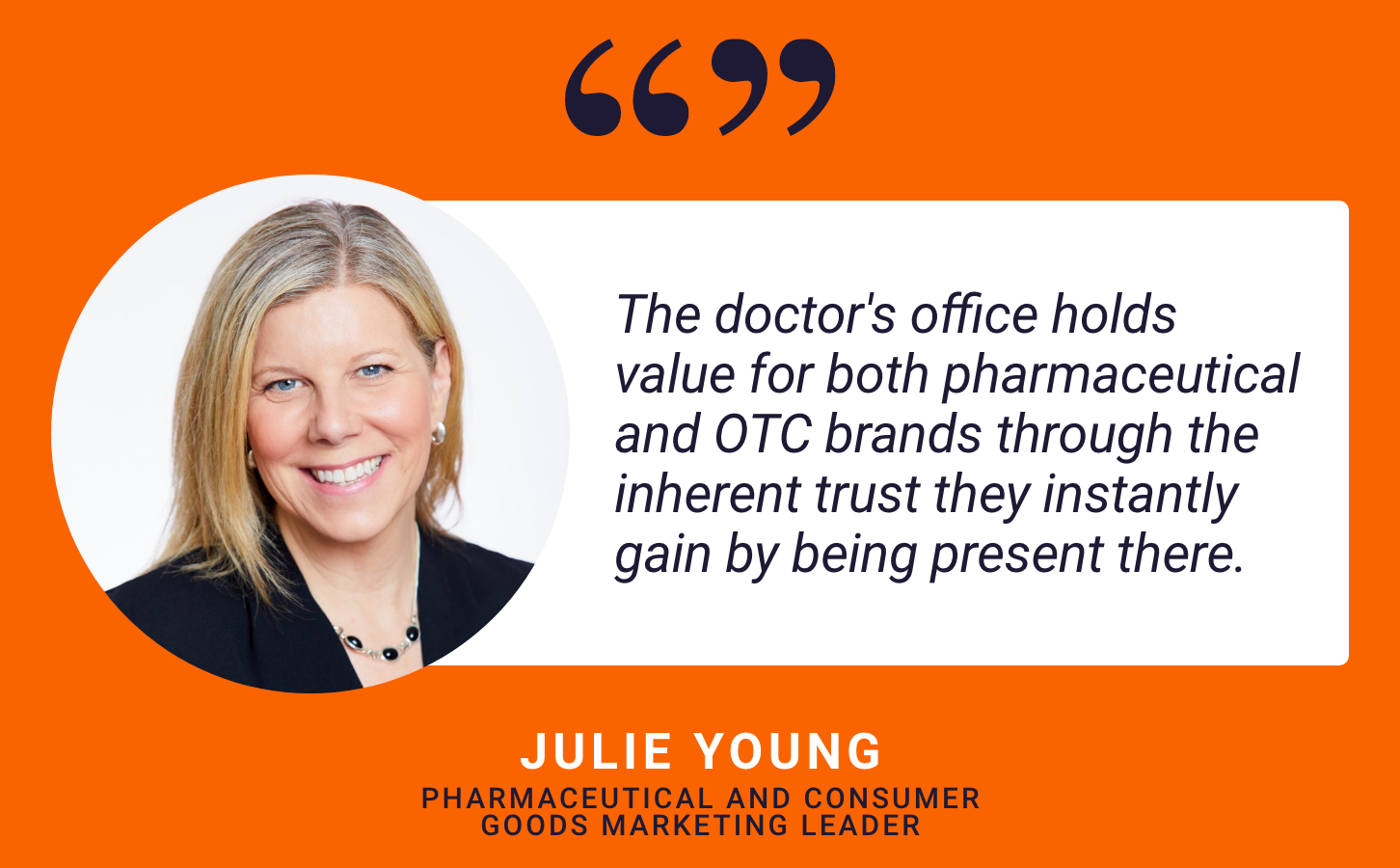I sat down with Julie Holcombe Young, one of the sharpest and most strategic pharmaceutical and consumer goods marketing leaders, to discuss the value of brand messaging at the doctor’s office. It’s a topic that Julie knows like the back of her hand, being a nearly 30-year veteran of the healthcare industry with an extensive background at such companies as Pfizer, Synergy Pharmaceuticals and Pharmavite.
Julie has a unique perspective on the value of Point of Care from both pharma and OTC settings, and I was eager to learn where she sees the value overlaps and unique benefits each segment receives from messaging at the doctor’s office.
Q: Point of Care is an obvious value proposition for pharma brands. Why is the doctor’s office also a beneficial channel for OTC?
The doctor’s office holds value for both pharmaceutical and OTC brands through the inherent trust they instantly gain by being present in the doctor’s office. The doctor’s office is a space where confidence in healthcare decisions already exists, so when a patient sees a brand in their HCP’s office, they instinctively trust that brand.
Additionally, the doctor’s office places brands in important health conversations. That conversation may not always be about a specific brand, but it could be about the condition that brand addresses, which can lead to scripts and product purchases.
Finally, for OTC brands, there is simply less advertising noise in the doctor’s office – especially compared to more traditional channels.
Q: Despite these benefits, it remains an underutilized channel among consumer health marketers. Why?
The main issue for OTC marketers is a lack of awareness about Point of Care. Another issue is an apprehension of breaking the norm. Many OTC marketers feel more comfortable working in traditional channels with traditional measures that are highly known and accepted. Lastly, OTC marketers want to stay in the same advertising spaces as their competitors and where their consumers are used to seeing them. However, these mindsets can slow brand growth and lead marketers to miss out on opportunities to engage with HCPs and their patients.
Q: What results can come from messaging at the doctor’s office for OTC brands?
At the most basic level, the doctor’s office builds brand loyalty and confidence. The implied endorsements brands gain from being in a trusted healthcare space can turn into brand purchases. For brands just entering the market – or smaller brands that may not have the dollars to invest in larger channels – this is an opportunity to outsmart the competition without having to outspend them.
It’s also statistically proven that there are significant differences in intent to purchase, product recall and condition/product-specific discussions between patients and HCPs who were exposed to point-of-care advertisements.
Q: How can messaging at the doctor’s office help drive the “#1 Doctor Recommended” claim?
Every brand wants the coveted “#1 Doctor Recommended” claim on its package! And the best way to earn that claim is by staying top-of-mind. It’s important to remember that patients aren’t the only ones exposed to brand ads. Healthcare professionals are also exposed to brand ads, and if healthcare professionals frequently see your brand, then they are more likely to recommend your brand when providing alternatives to prescription therapies.
Q: How is the success of HCP promotion measured? What do OTC marketers need to keep in mind when it comes to measurement within this channel?
It’s really the opposite of what we do for prescription brands. With pharma brands, we can often see a direct tie to the doctor from prescription data. However, a reverse approach is needed for OTC brands. Quantitative studies ask HCPs their usual OTC brand recommendations by category or condition – which is strong data for this claim.
An additional measure is a post-purchase survey of consumers. By asking consumers questions such as where they first heard about the brand or who recommended the brand to them, we can see the impact specific to HCPs. If the consumer indicates a doctor recommended the brand, we can follow up and get the doctor’s name, or we can tie the consumer’s zip code to a practice location.
Q: Doctor vs. pharmacist: Why is the doctor the ultimate influencer today?
The doctor’s recommendation often carries more weight than that of the pharmacist. The pharmacist continues to be a trusted resource for patients, but today pharmacists are limited in the retail setting and don’t have the time or influence that doctors do. A doctor’s recommendation of a product before a patient even walks into a pharmacy helps mitigate that lack of pharmacist interaction.
Q: Describe your experience partnering with PatientPoint, from a pharma and OTC perspective.
I’ve had the opportunity to work with PatientPoint in both the pharma and OTC setting, which I suspect not a lot of healthcare business leaders can say! In both cases, it’s been a true strategic partnership. The brand objectives have always been the priority, and considerations for reach, frequency and budget were addressed. PatientPoint understands that investing in Point of Care needs to be done with a test-and-learn mentality so that true impact can be measured and optimized. I have always appreciated our partnership.
Learn more about the benefits of partnering with PatientPoint here.

